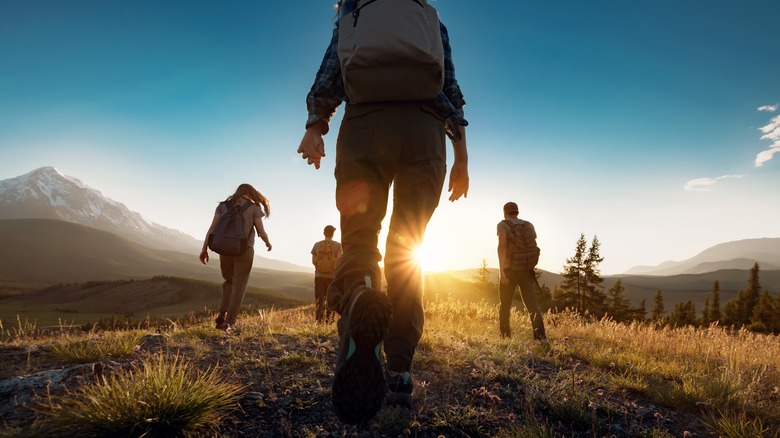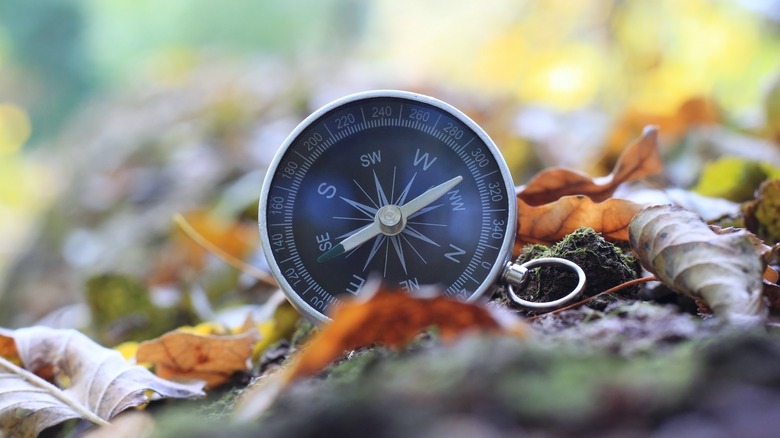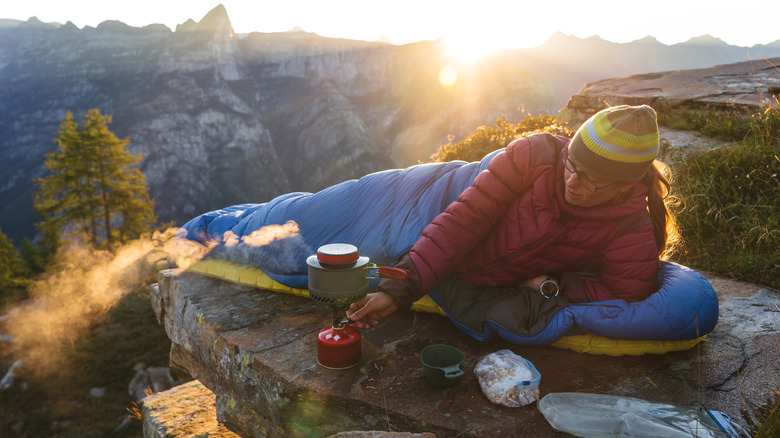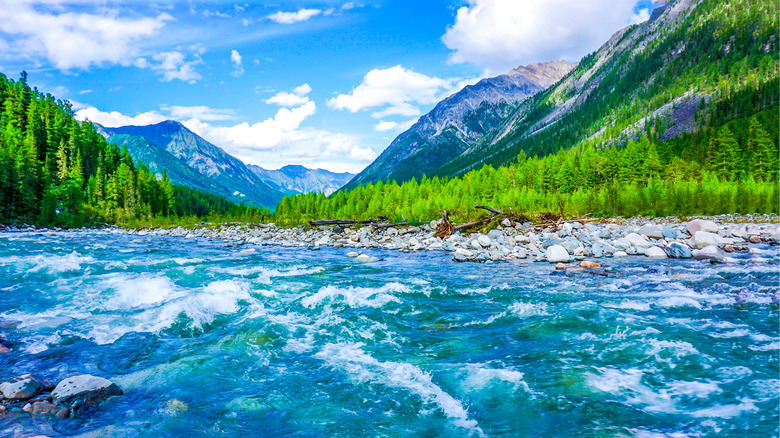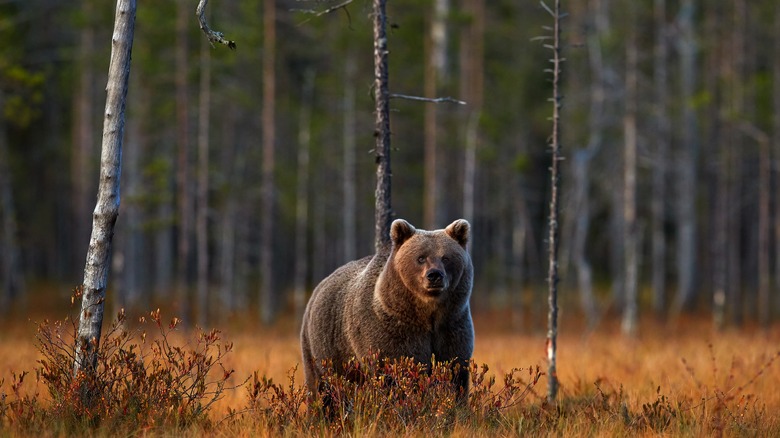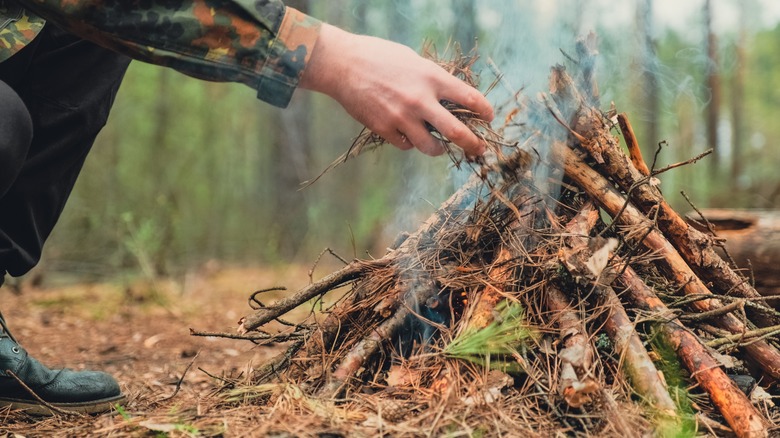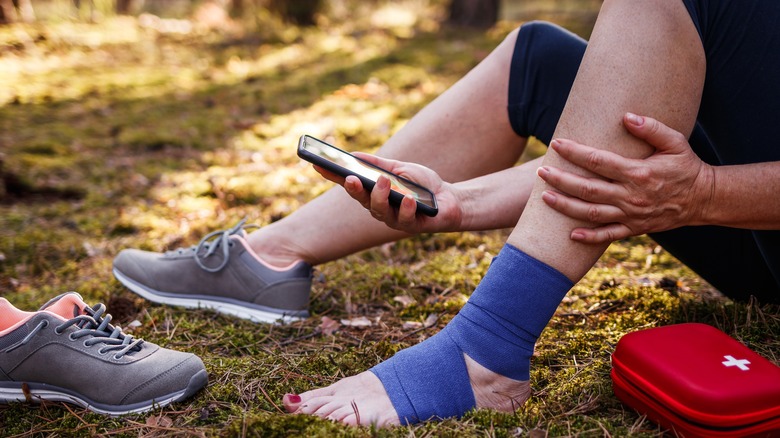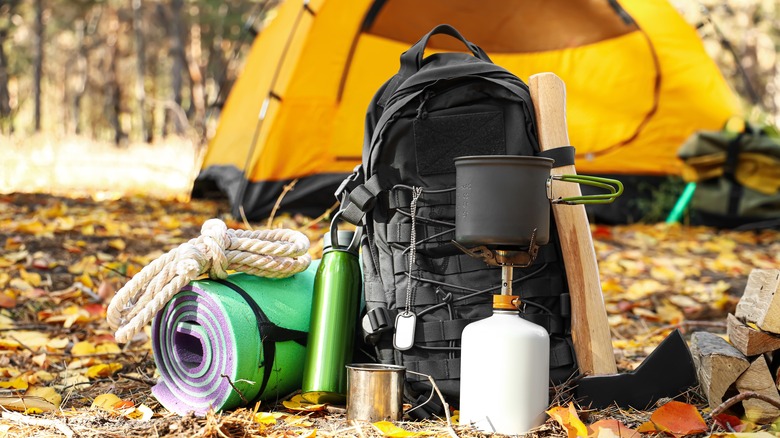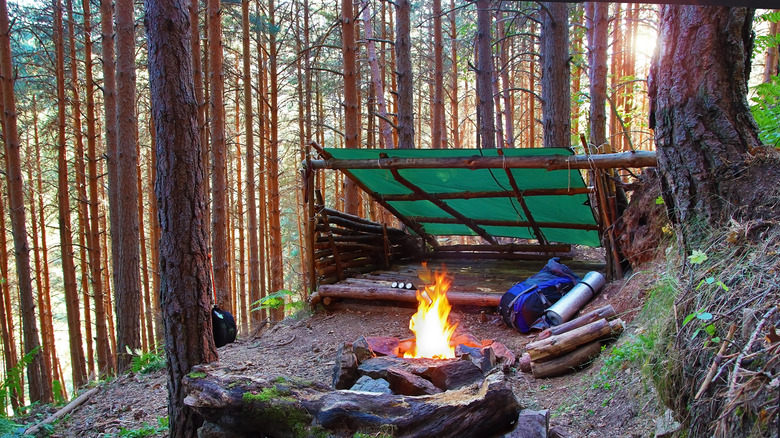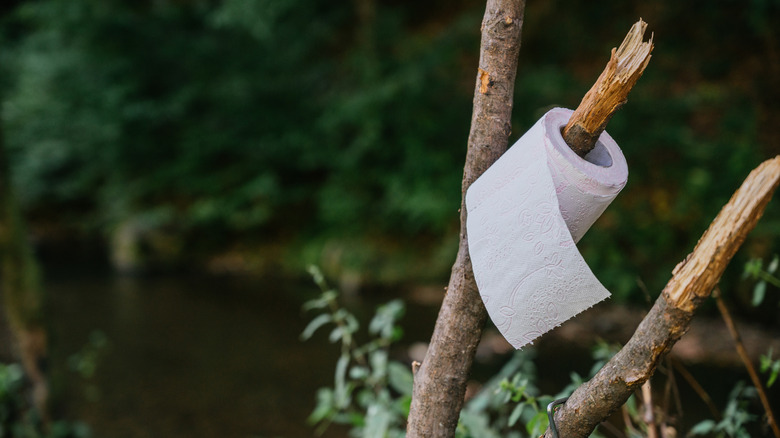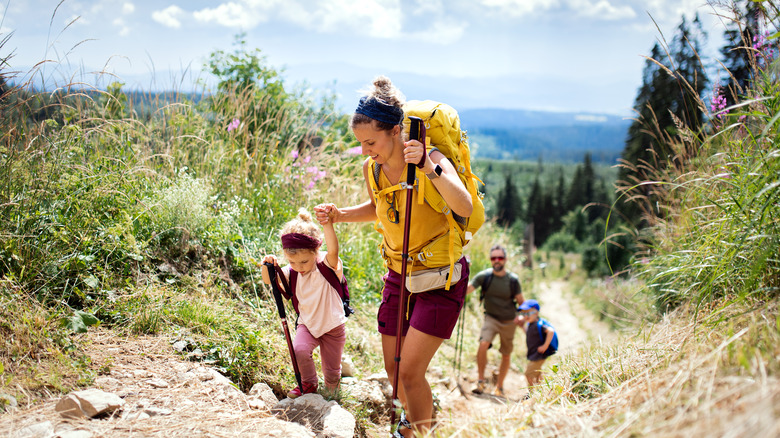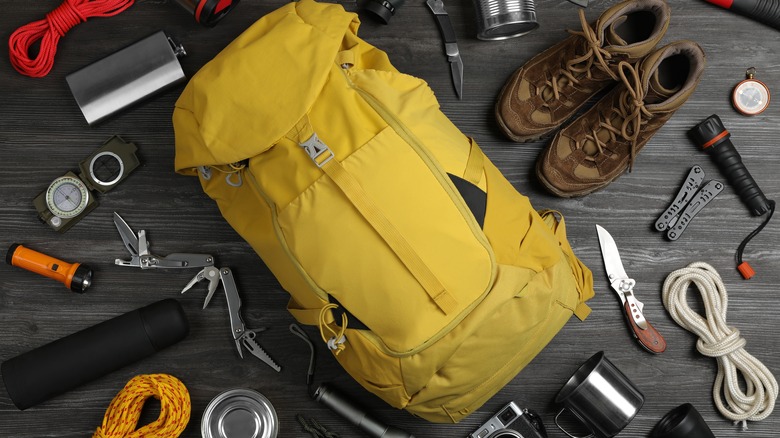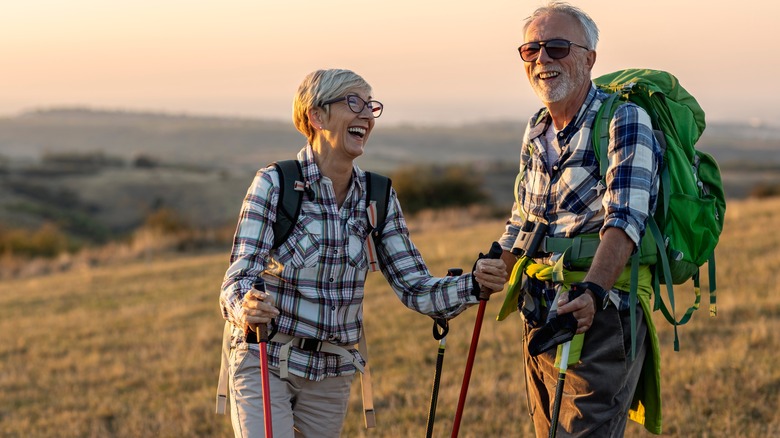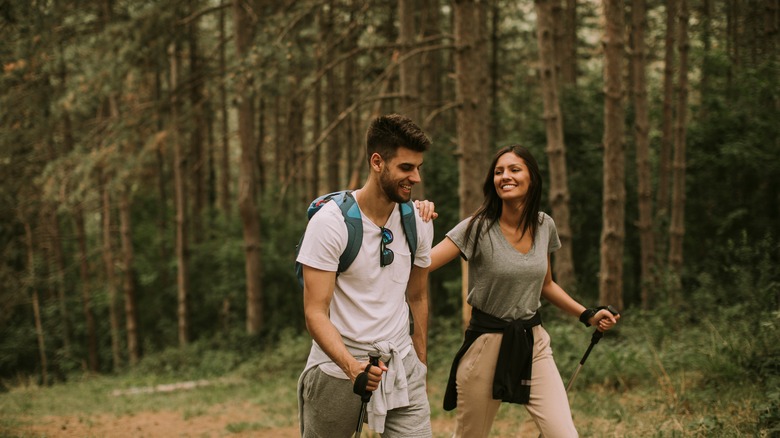Skills Every Backcountry Explorer Should Master
There's something truly special about roaming off the beaten path. You can see some really beautiful places traveling by car, visiting a national park or scenic rest stop, or car camping — but going into the backcountry can bring you to places that words can never do justice. There's nothing quite like leaving the hustle and bustle of the city to be surrounded by peaceful sounds of nature and wind moving through the trees. The backcountry is also typically less crowded than popular hiking trails, allowing you to feel more immersed in nature.
Spending time in the wilderness also offers a whole realm of health benefits: reducing feelings of stress, anxiety, and depression, boosting self-esteem and confidence, and promoting an overall sense of well-being (via Healthline). Plus, if you're going backpacking, you're likely to get a decent workout that can help you maintain a healthy weight, build strong bones, and increase your physical stamina (via Ecobnb). While some love the idea of being further away from town, being in the backcountry also means the amenities of the city are not nearby — but don't worry, with some preparation and skill building, you will be ready for anything Mother Nature throws your way.
How to navigate
First things first: We don't want to get lost out in the wilderness, especially without cell service. Learning how to read a map and utilize a compass is the first step to successfully traversing the backcountry. Of course, it's also important to remember to pack these tools, too. Whether your plan is to stick to the trail or go forge your own, both of these items are essential to your adventure. After all, you can't always rely on your smartphone to tell you where you are. There's likely no service in the backcountry, and if your phone dies or gets wet, it'll be of no use.
When you get your compass, familiarize yourself with its parts and what they do. All compasses should have a magnetized needle. The most important thing to remember is that this needle points to the magnetic north, not true north. Declination refers to the angle between magnetic north and true north, and your compass should have a declination scale to help you figure it out. Your declination will change depending on where you're located. Most maps have a declination diagram to help you determine the angle of declination, which is a number of degrees paired with a direction, like east or west. Declination can change over time as the tectonic plates shift, so it's best to have a recent map to get an accurate measurement. After you determine your declination, subtract it when the compass is bearing west and add it to the east (via Backpacker).
How to cook in the wilderness
Food is essential for survival. When you're trekking through tough terrain, you're likely expending hundreds or even thousands of calories more than usual. Often for overnight trips, the goal is to pack food that is both nutritious and lightweight. Even if you're doing a day hike, it's important to put thought into the food you bring with you. It's better to have more snacks than needed, considering you'll probably work up a hunger while out in the wilderness.
If you're planning to stay the night in the backcountry, focus on bringing high-calorie and high-carb meals like instant potatoes, pasta, or easy-to-cook grains like oats. Leafy greens and vegetables are nutrient-dense, but they're hard to keep fresh without a cooler. If you can, try to dehydrate fruits and vegetables ahead of time to bring with you (via Outdoor Project). You'll also need to bring gear to cook your food, like a camping stove and a small frying pan or pot. Don't forget to bring more fuel than you think you'll need, as well as a lighter and matches. Try to cook whatever meals you plan on eating outdoors before you're in the backcountry, this way you'll know what to expect and how to prepare.
How to find and filter your water
Water — another essential for survival — is the heaviest thing you'll have in your pack. If you're going into the wilderness for multiple days, you won't want to carry all the water you'll need for your entire journey from day one. Instead, you'll need a trusted water filtration device and a backup plan in case it breaks. Study your map ahead of time to confirm where the water sources are and plan your trek accordingly. While drinking straight from a clear lake may seem tempting, it's a good idea to filter any water you come across to sift out anything that could make you sick. A water filter is all you need to get rid of bacteria, but if the area you're traveling in is polluted, a water purifier will be more effective for filtering out viruses (via National Geographic).
Be sure to stay away from murky water because algae, which is what clouds up the water, is a sign that it will be unsafe to drink (via Pacific Crest Trail Association). Avoid taking from any unclear bodies of water, even if you plan on filtering it. Alpine streams are the best water sources, but clear-water lakes can also be a good option. Avoid choosing water where there is evidence of animal feces or cattle upstream. If all else fails, remember you can bring water to a boil before consumption to guarantee that it'll be safe to drink (via the Centers for Disease Control and Prevention).
How to protect yourself from bears
When you're wandering into the wilderness, you're entering the home of wild animals. While it's a thrill to see marmots, mountain goats, and bald eagles; seeing a bear can trigger both excitement and fear. Bear safety is an essential backcountry skill. Your first goal is preventing a bear from finding you. This means planning for appropriate food storage. If you're spending the night in the backcountry, you should pack a bear canister or a good amount of string to hang your food high in a tree, away from your tent. Since bears have such a keen sense of smell, you'll want to put anything that smells into your bear canister, including food, soap, deodorant, and trash (via American Bear Association).
If you see a bear, do not run. Try to stay calm and make yourself as big as possible by standing up tall and putting your arms in the air. Begin to speak to the bear, so it can understand you are a human and not a threat, as you slowly back away without turning your back on the bear. If the bear follows you, stay still and be loud by yelling, clapping, or throwing a rock toward them. If you're going into heavily-populated bear country, you may want to carry bear pepper spray with you. Only use bear spray if a bear attempts to attack you (via National Park Service).
How to build a fire
Making a fire is an essential outdoor skill, especially in dire situations. Fire can keep you warm and cook food if your stove breaks. First and foremost, check fire regulations to confirm there are no current fire bans in the area you're in. If there is not one already, you will need to make a fire pit, avoiding places near low-hanging trees or dry brush. Clear away all plant material to form a 10-foot wide diameter of bare dirt. Dig a hole that is at least 2 feet wide and 6 inches deep, then line your fire pit with dirt or rocks (via Pacific Crest Trail Association).
The easiest way to build a fire is by making a pyramid. You can do this by pushing a small stick into the ground, then surrounding it with flammable plant materials, like moss, dead leaves, and dry grass. for tinder. Light your tinder, then start to lean sticks on your foundation, setting them up in a teepee-like shape. Continue to slowly add sticks until coals form, then you can add larger wood. The key is to add plant material slowly in order to avoid smothering the fire. Only harvest fallen plant parts, never take from living plants (via Outdoor Project). Always keep watch of the fire and make sure to put it out by smothering it with dirt and water before you go to bed or leave the area.
How to prepare for medical mishaps
When you're out in the middle of nowhere, you are very far away from the hospital. And depending on where you are, you may not have cell service or be able to call for help if you get hurt. Learning emergency skills like cardiopulmonary resuscitation (CPR), the Heimlich maneuver, and basic first-aid is essential.
Many of these techniques are far too complex to master just by reading this article, but you can take a class online or in person through American Red Cross. You can also attend a wilderness first-aid course, where you'll learn how to use your surroundings to accommodate any issues you might encounter. Some of the common skills you should consider mastering include how to properly clean a wound, how to stop heavy bleeding, how to make a splint, and how to respond to situations like shock, hypothermia, diarrhea, vomiting, fever, sprains and broken bones (via Primal Survivor). Be sure to carry a first-aid kit with you while in the backcountry, so you have the necessary tools on hand if something happens. You can build your own first-aid kit or buy a pre-made one through places like REI or Walmart.
How to deal with snakebites
While snakebites aren't that common — only about 8,000 happen per year — it's still important to know how to respond to one in an emergency (via Johns Hopkins Medicine). There are numerous snakebite myths out there that have been kept alive by movies and the media (via BTG Specialty Pharmaceuticals). For the record — do not attempt to suck out snake venom or apply a tourniquet. Sucking it out with your mouth or a device will not work, and a tourniquet may cause additional harm to the victim.
Unless you are 100% sure the snake was not venomous, a snakebite requires immediate medical attention. If it was a venomous snake that bit you, you'll need access to anti-venom to avoid serious illness or death (via Smithsonian Institute). According to Johns Hopkins Medicine, you should immediately wash the wound with warm, soapy water and keep the area affected below the victim's heart. Cover the area with a clean, cool compress and monitor breathing and heart rate. You'll likely need to get to a hospital as soon as possible if someone is bitten by a snake in the backcountry. Since you might not have reliable cell service, you should consider getting a satellite-based communication device or a personal locater beacon (via Pacific Crest Trail Association).
How to tie a knot
Learning how to tie your shoes is great, but you'll need more than that in the backcountry. It's helpful to know how to tie different knots while in the wilderness so you can effectively hang up your bear bag or tie down things to your pack. The top three most useful knots are the bowline, half hitch, and fisherman's knot.
The bowline knot is recognized worldwide and is great for tying down a tent. The half hitch is your basic, go-to knot because it's used to tie a rope around an object and back to itself. Two half hitch knots can also make the rope able to bear significant weight. The fisherman's knot is useful for tying two ropes together, which can come in handy if you have several pieces of rope that aren't as long as you need them to be. The best way to learn how to tie these knots is to gather some rope, find a tutorial video, and practice. Before your trip, practice many times at home until you have them memorized and mastered (via Backpackers.com).
How to build a shelter
Learning how to build a shelter in any situation is the key to being able to survive in an emergency. While most of us rely on a tent as our shelter in the wilderness, it's important to know how to create an alternate solution in the event that your tent breaks, gets lost, or if you forget to pack it altogether.
There are a few things to consider when choosing a shelter site. You want to make sure the area is dry, flat, not near any rocks or tree limbs that can fall on top, and that you can fit a fire near the entrance. If you have a tarp and some rope, you may consider building a basic tarp shelter, a teepee of sorts, or an improvised tent of sorts. If you don't have a tarp, your next best bet is to find a fallen tree and prop branches on it to form walls and a ceiling to protect you. Alternatively, you could build a small A-frame shelter using large branches and trees (via Primal Survivor).
How to go #2
What do you do when nature calls ... in nature? While learning how to go #2 isn't necessarily a master skill, knowing how to do so in the wilderness with "leave no trace" principles is extremely helpful and environmentally sound. First, you'll want to make sure to pack the right tools for the job: a shovel, toilet paper, ziplock bag, and hand sanitizer.
Second, make sure the spot you choose is at least 200 feet away from a water source, trail, or campsite. Using your shovel, dig a hole that is at least 6 inches deep and 4 inches across. Yes, this is your toilet. Dispose of the used toilet paper in your ziplock bag and cover the hole with the dirt you dug up. Pat the soil down and cover the spot with rocks or sticks to discourage animals or humans to go digging around the area (via REI). Some wilderness regions require you to pack out the waste as well, so be sure to do research on the area you're exploring before you go.
How to pick the right clothing
It may seem trivial, but wearing the right clothes can make or break an outdoor adventure. Packing and wearing layers is always a great option because it allows you to adjust your outfit quickly as the temperature changes. Wearing a good base layer is key to a successful trip. Wool is your best bet, as it has many beneficial selling points — it helps keep your body warm when it's cold, cool you down when it's hot, and it can warm you up when you're wet. Plus, wool is biodegradable and antibacterial, which means it helps keep body odor at bay, so you can wear the same outfit several days in a row on your multi-day expedition (via National Geographic).
As far as layers go, it's a good idea to pack one of everything — that means one tank top, one long-sleeve shirt, one pair of shorts, one pair of pants, and one hat of some sort. Of course, you'll want multiple pairs of your essentials, like socks and underwear. Also, don't forget to throw in a puffer jacket that will keep you warm and dry when you're wearing it, but folds up nicely to fit in your bag when it's too warm to have it on.
How to get creative with your gear
Less is more when it comes to the gear you'll need for long backpacking trips. You'll want to bring all of the things you will need, but you also want to keep your pack as lightweight as possible so you don't get exhausted after five minutes of carrying it. Try to keep an open mind and get creative with the things you decide to bring with you on your journey. Everything you pack can be multi-use if you want it to be.
For example, dental floss can be used as a string, aluminum foil is great for cooking and as wind blockage for building a fire, and rubber bands can be used for anything from a hair tie to a tourniquet. If you like to carry moleskin to treat blisters from hiking boots, those could also be used if you need to patch a hole in your jacket or tent (via National Geographic). The key is to put thought into everything you pack, so you only bring the things you absolutely need.
How to be prepared mentally and physically
The truth is, nature is both beautiful and dangerous at the same time. You will see gorgeous things that blow you away, and no matter how many pictures you take, they just won't live up to the real thing. But the wilderness is called the wild for a reason. You should be prepared for things to go wrong, both mentally and physically, so you won't be caught off guard if they do. Think of worst-case scenarios and backup plans and prepare yourself mentally for physical exhaustion. If you're going on an especially long trip in the backcountry, you should train for the hike that you know might be physically demanding.
Start preparing for an outdoor adventure well in advance by researching where you are going, acquiring and studying the maps, getting all your gear in order, planning and prepping your food, working out, and doing anything else that will make you feel more prepared. All of these preparations will help you feel less anxious and more ready to take on whatever happens out there in the great unknown (via National Geographic).
How to leave no trace
One of the core principles of going into the wilderness is the practice of leaving no trace. This concept is exactly what it sounds like — you want to leave no trace that you were actually there. This idea goes far beyond not leaving trash behind. Minimizing your impact on the environment requires mindfulness when you're out there. If you're backpacking on a trail, stay on the trail — going off-trail squishes plants and can harm wildlife.
You'll probably hear the phrase "pack it in, pack it out" when referring to any backpacking trips. This means you'll want to both come and go with the same items in your bag, meaning you leave nothing behind in the wilderness. This even includes compostable things, like food, nut shells, and fruit peels. Avoid intentionally damaging rocks, trees, or plants in the area. Also, try to minimize your campfire impact by using stoves to cook and only building a fire if it's necessary. If you do need a fire, try to use existing fire rings to avoid digging a new one. Keep your fire relatively small and never burn trash while you're in the woods (via Pacific Crest Trail Association). And of course, as tempting as it is, don't take home any souvenirs beyond the pictures you take on the trail.
